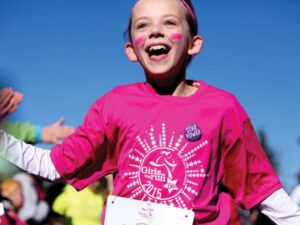When you’re busy and juggling multiple priorities, staying physically fit often gets put on the backburner. However, you still want to make sure your childr is still getting what he needs so he can be the healthiest version of himself. According to the National Institutes of Health, physical fitness lowers the risk of many diseases, including heart disease, diabetes, and cancer, and it also improves mental health and cognitive function. For growing children, physical activity is important not only for its immediate health benefits, but also to help them build strong bodies and instill healthy habits that will last a lifetime. So if fitness isn’t a top priority for you, how can you make fitness a priority for your child?
Make it fun
Local experts agree—if you want to get kids to be more active, make it fun. “I don’t use the word ‘exercise’,” says Gwen Bowie, wellness director for YMCA of the Capital Area. “It sounds laborious and boring. I say, ‘physical activity’—and there are many physical activities that can be done at any age that will boost your fitness level and get your heart rate going, such as walking, biking, swimming, and dancing. If my mom said to me, ‘Let’s go out and exercise today,’ that’s almost like saying, ‘Let’s clean house today.’ But if she said, ‘Let’s head out to the park and ride our bikes,’ that sounds so much better!”
Carley Wahlborg, communications director for Girls on the Run South Louisiana adds, “It needs to be throughout their childhood that they learn there are many ways to move their bodies and to experience the joy and health that comes from that. When children experience the joy of movement, that focus on fitness just comes naturally.”
Changing up the activities each day will also help keep things fun for the children. “I give them options, but structured options,” says Josh Roberts who runs GymFit at Elite Gymnastics in Baton Rouge. “I make it fun and change it up for them so they don’t get bored. One day, we’ll do strength conditioning, another day we’ll do acroyoga, and then we’ll have open gym days.”
Be a leader
Roberts emphasizes parents’ roles in setting a positive example for their children when it comes to fitness.
“One of the biggest things in getting kids active is participating with them,” says Roberts. “That way, they’re more likely to stick with it. It provides accountability. So if Mom wants to skip the gym one day, the kids will say, ‘Come on, Mom, let’s go,’ and vice versa.”
Wahlborg agrees and emphasizes, “Children can go outside and play at a very young age. If parents can be leaders on that, taking them out for walks when they’re young, and leading and supporting them in activities that encourage movement, then the kids can find out for themselves what activities they enjoy the most.”
In addition to participating, parents can also take the lead in planning and scheduling. Bowie concurs, “Like anything else, for it to be a priority, the parent has to be a role model. Just like parents will schedule and put their kids in outside activities, making time for fitness has to be a priority as well.”
Find friends
As children grow older and develop their own interests, the physical activities that appeal to them may differ from those of their parents and siblings. Parents can continue to lead by supporting their children’s interests, even if they don’t participate in the same activities. Friends and peers can be great for kids to exercise with, too.
At the YMCA, team sports, swim classes, and after-school programs give kids a wide variety of ways to get active and socialize at the same time.
At first, GymFit only offered classes for adults. Then, Roberts got a call from a homeschool mother who was looking for options when she could no longer afford to keep her son on his gymnastics team. Roberts decided to open up his gymnastics classes to kids, and now he has a whole group of homeschool kids who come by not only to exercise, but also to socialize.
In addition to socialization, Girls on the Run also uses running and movement to teach girls how to set goals to build confidence as well as to support each other as teammates.
“As they’re learning, they’ll have little games, like a relay, where they’ll run from one end of the field to the other, and when they come back, they’re cheering out a positive affirmation about themselves or about someone else in the group,” Wahlborg says. “When girls are able to associate movement with positive things and with learning, it encourages them to be more active. It’s really great to involve children in team activities and things that allow them to set goals. And wherever that takes them, then parents can support that and lead their children.” ■
Fun Ways for Kids to Get Moving
Girls on the Run South Louisiana offers programs for girls in grades three through eight that teach running and movement as a pathway to self-confidence and goal-setting. They also offer scholarships based on financial need. Their annual 5K event in Baton Rouge—open to all men, women, and children—will be on May 7. ■ girlsontherunsola.org
GymFit at Elite Gymnastics offers a range of gymnastics-based fitness opportunities including strength conditioning, acroyoga, and open gym days for boys, girls, men, and women of all ages. ■ (225) 766-7070
YMCA of the Capital Area offers year-round indoor swimming lessons, sports programs, after-school programs, family fitness, and kids’ fitness opportunities. Their robust scholarship program ensures that no one is ever turned away for inability to pay. ■ ymcabr.org





